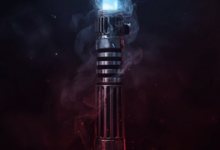Orange Lightsaber – The Blade of Balance, Uncertainty, and the Unknown

The lightsaber has always been more than just a weapon in Star Wars. It is a reflection of identity, philosophy, and a Force user’s connection to destiny. While blue, green, and red sabers have defined much of the saga’s history, orange lightsabers have quietly emerged as one of the most intriguing and mysterious blade colors in the galaxy.
The orange lightsaber exists in the space between light and dark, between tradition and rebellion. It is a rare color, seldom seen, but deeply symbolic. Those who wield orange sabers often walk a path that does not follow the Jedi or the Sith. These Force users operate in the grey, guided not by rules or codes, but by instinct and necessity.
In this article, we’ll explore the meaning of the orange lightsaber, its place in Star Wars canon and Legends, notable wielders, its combat style associations, and what it represents for fans and storytellers today.
What Does the Orange Lightsaber Represent?
The orange lightsaber is a symbol of balance, caution, and independence. It suggests a Force user who may have stepped away from rigid teachings of the Jedi Order but has not embraced the destructive hunger of the Sith. Orange is the color of firelight, twilight, and warning. It glows with the energy of transformation.
Force users who wield orange sabers are often aligned with neither side in a galactic conflict. They may have once trained as Jedi, or even brushed against the dark side, but they have chosen their own path. Their decisions are personal. Their missions are often secretive. Their actions don’t always match their words.
The color orange sits between red and yellow on the spectrum. Red, the color of passion and aggression. Yellow, the color of discipline and vigilance. Orange reflects the tension between those ideas. Passion restrained. Power with purpose.
Traits of orange saber wielders often include
- Deep independence
- Strong will and personal code
- Tactical decision-making
- Cautious use of power
- An awareness of both sides of the Force
The Rise of Orange Sabers in Canon
For much of Star Wars history, orange lightsabers existed only in Legends and fan-created stories. That changed with the release of new Star Wars stories set in different timelines and styles.
The High Republic era, which explores the Jedi Order at its peak, has hinted at variations in lightsaber colors, though orange has not yet been heavily featured in canon novels or comics from that era. However, the visual language of that time hints at a broader range of saber colors being accepted within the Jedi Order.
The most significant canon appearance of orange sabers came in the Ahsoka live-action series, where a mysterious pair of Force users, Baylan Skoll and Shin Hati, wield orange-red blades. These sabers are not fully red, but their orange hue suggests they are not standard Sith weapons either.
This deliberate color choice implies a different kind of Force user. One who does not fit neatly into Jedi or Sith labels. It reflects tension. Uncertainty. Perhaps even a new understanding of the Force that breaks away from tradition.
Orange Sabers in Legends and Games
Before their appearance in canon, orange lightsabers appeared in video games and Legends material. These appearances helped build the foundation for their modern meaning.
In the game Star Wars Jedi: Fallen Order and its sequel Jedi: Survivor, players can unlock an orange lightsaber color. This option is purely cosmetic but quickly became popular among fans who wanted their character to reflect something different — a Jedi survivor walking alone, unsure of their place in the galaxy.
In Legends, orange lightsabers were sometimes used by Gray Jedi, Force-sensitive warriors who followed their own moral code. These Jedi did not fully accept the Jedi Council’s teachings, nor did they give in to the dark side. They walked a narrow line, and their saber color reflected that inner balance and struggle.
Notable Wielders of Orange Lightsabers
Baylan Skoll
A former Jedi who survived Order 66 and later became a mercenary and Force user. In the Ahsoka series, Baylan’s saber burns with a deep orange glow. He is not a Sith, but his philosophy rejects the Jedi Order. His goals are unclear, but his saber color suggests that he walks a different path. One marked by knowledge, caution, and ambition.
Shin Hati
An apprentice of Baylan, Shin wields a similar orange saber. She is aggressive and driven, but like her master, she does not claim the title of Sith. Her saber and behavior suggest someone who is being shaped by conflicting ideas — loyalty, power, and personal purpose.
Cal Kestis (Player-Choice)
While not canonically tied to orange, players in Jedi: Fallen Order and Jedi: Survivor can wield orange blades. Given Cal’s position as a survivor of the Jedi Purge, his struggles with anger and purpose, and his independent journey, the orange blade fits him symbolically.
Combat Styles and Philosophy
Orange saber users typically do not follow traditional Jedi lightsaber forms. Instead, they develop personal styles based on experience, necessity, and their connection to the Force.
Some may mix elements of defensive forms like Soresu with aggressive moves from Djem So or Juyo. Others may rely on unpredictable, unrefined combat techniques developed through survival, not training.
Because orange saber users often operate alone, their fighting style is more reactive. More adaptive. More personal. It reflects the world they live in — one where certainty is rare and survival depends on intuition.
Their philosophy is similar. Orange saber wielders trust themselves above doctrine. They follow what they believe is right, even if it conflicts with Jedi ideals. They are more likely to act in grey areas, take on dangerous missions, or use the Force in ways considered unconventional.
They are not reckless. But they are not ruled by caution either.
Orange Sabers and Fan Interpretation
In the fan community, orange lightsabers are often used for characters who exist in the middle of the Force spectrum. Not Sith. Not Jedi. Something new.
Cosplayers and writers who build Force-sensitive bounty hunters, former Jedi exiles, or secret protectors of ancient knowledge often choose orange blades. The color gives their characters room to grow, fall, or redeem. It adds layers of complexity and mystery.
In saber-building communities, orange blades are paired with hilts that look ancient, weathered, or custom-forged. Many include symbols that blend Jedi and Sith elements, suggesting a history that is long, painful, and personal.
Orange lightsabers also pair well with characters who are Force-sensitive but not Force-trained. These individuals may have discovered their abilities later in life and forged a saber without guidance. Their blade is a reflection of raw potential.
What Makes the Orange Saber Unique
The orange saber is not loud. It is not flashy. It does not draw attention like red or glow with purity like blue. Instead, it burns with quiet power. With depth. With questions.
It speaks to those who do not follow. Who lead themselves. Who carry the burden of the Force without needing to wear a title.
It is a blade for the forgotten, the wandering, the ones who know the cost of war and peace. The ones who understand that the Force is not just light or dark. It is choice. It is consequence.
Legacy
The orange lightsaber is a rare and powerful symbol in Star Wars. It represents those who refuse to be defined by the past. It belongs to those who question everything and fight for what they believe is right, even when the galaxy offers no clear answers.
From the shadows of the Clone Wars to the unexplored regions of the galaxy, the orange saber continues to spark curiosity and admiration. Its light may be subtle, but its message is strong.
To carry an orange saber is to walk your own path. To seek balance without borders. To face the unknown without fear.
In every age, there are warriors who choose the blade not of tradition, but of truth. And their light shines orange.







